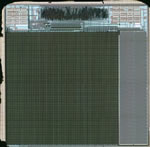Fluorescence Lifetime Imagers
Traditional Fluorescence Lifetime Imaging Microscopy systems use laser scanning techniques in concert with a single photon detector, such as a photomultiplier tube or avalanche photodiode, to construct lifetime based images using Time Correlated Single Photon Counting (TCSPC). In order to acquire enough data within each pixel to determine the lifetime, thousands of samples must be taken. As a result, the time required to capture a single frame can be several to tens of seconds, which presents a limit to the types of biological processes that can be monitored using FLIM. The focus of this project is creating a CMOS-based Single Photon Avalanche Diode (SPAD) array that is capable of acquiring multiple frames per second, which would make real-time FLIM imaging of biological processes possible.
 Our most recent array design was capable of a maximum frame rate of 3.9 Hz and consisted of a 64 x 64 SPAD array with integrated timing and pixel control circuitry in 0.35μm technology. The image on this page below shows a FLIM image of quantum dots (in color) next to a CCD image showing the location of the quantum dots on the array.
Our most recent array design was capable of a maximum frame rate of 3.9 Hz and consisted of a 64 x 64 SPAD array with integrated timing and pixel control circuitry in 0.35μm technology. The image on this page below shows a FLIM image of quantum dots (in color) next to a CCD image showing the location of the quantum dots on the array.

Our recent efforts are focused on developing a SPAD array in a standard CMOS process flow for a more advanced technology node. We have developed a low-noise SPAD in 0.13μm technology that will enable higher imaging rates through improved circuit performance. A full imaging array based on this SPAD design is currently under development.
Related Publications:
R. M. Field, J. Lary, J. Cohn, L. Paninski, and K. L. Shepard, “A low-noise, single-photon avalanche diode in standard 0.13 μm complementary metal-oxide-semiconductor process,” Applied Physcis Letters, 97, 211111 (2010).
Abstract
We present the design and characterization of a single-photon avalanche diode SPAD fabricated with a standard 0.13 m complementary metal-oxide-semiconductor process. We have developed a figure of merit for SPADs when these detectors are employed in high frame-rate fluorescent lifetime imaging microscopy, which allows us to specify an optimal bias point for the diode and compare our diode with other published devices. At its optimum bias point at room temperature, our SPAD achieves a photon detection probability of 29% while exhibiting a dark count rate of only 231 Hz and an impulse response of 198 ps.
D. E. Schwartz, E. Charbon, and K. L. Shepard, “A single-photon avalanche diode imager for fluorescence lifetime applications” Symposium on VLSI Circuits, 2007, pp. 144-245.
Abstract
A 64-by-64-pixel CMOS single-photon avalanche diode (SPAD) imager for time-resolved fluorescence detection features actively quenched and reset pixels, allowing gated detection to eliminate pile-up nonlinearities common to most time-correlated single-photon counting (TCSPC) approaches. Reset Timing information is collected using an on-chip time-tocalb calibrated digital converter (TDC) based on a counter and a supply- interpolators regulated delay-locked loop (DLL).




